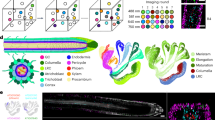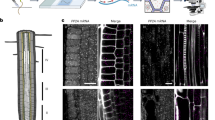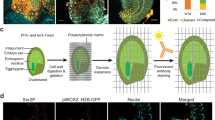Abstract
Plant biology is currently confronted with an overflow of expression profile data provided by high-throughput microarray transcription analyses. However, the tissue and cellular resolution of these techniques is limited. Thus, it is still necessary to examine the expression pattern of selected candidate genes at a cellular level. Here we present an in situ mRNA hybridization method that is routinely used in the analysis of gene expression patterns. The protocol is optimized for mRNA localizations in sectioned tissue of Arabidopsis seedlings including embryos, roots, hypocotyls, young primary leaves and flowers. The detailed protocol, recommended controls and troubleshooting are presented along with examples of application. The total time for the process is 10 days.
This is a preview of subscription content, access via your institution
Access options
Subscribe to this journal
Receive 12 print issues and online access
$259.00 per year
only $21.58 per issue
Buy this article
- Purchase on Springer Link
- Instant access to full article PDF
Prices may be subject to local taxes which are calculated during checkout


Similar content being viewed by others
References
Braissant, O. & Wahli, W. A simplified in situ hybridization protocol using non-radioactively labeled probes to detect abundant and rare mRNAs on tissue sections. Biochemica 1, 10–16 (1998).
Lincoln, C., Long, J., Yamaguchi, J., Serikawa, K. & Hake, S.A. knotted1-like homeobox gene in Arabidopsis is expressed in the vegetative meristem and dramatically alters leaf morphology when overexpressed in transgenic plants. Plant Cell 6, 1859–1876 (1994).
Heisler, M.G., Atkinson, A., Bylstra, Y.H., Walsh, R. & Smyth, D.R. SPATULA, a gene that controls development of carpel margin tissues in Arabidopsis, encodes a bHLH protein. Development 128, 1089–1098 (2001).
Brewer, P.B. et al. PETAL LOSS, a trihelix transcription factor gene, regulates perianth architecture the Arabidopsis flower. Development 131, 4035–4045 (2004).
Hejátko, J., Pernisova, M., Eneva, T., Palme, K. & Brzobohaty, B. The putative sensor histidine kinase CKI1 is involved in female gametophyte development in Arabidopsis. Mol. Genet. Genomics 269, 443–453 (2003).
Acknowledgements
We are very grateful to David Smyth for providing laboratory facilities and advice during the establishment of this protocol. J.H. was supported by the Ministry of Education of the Czech Republic (LC06034, MSM0021622415), P.B.B. and J.F. by the VolkswagenStiftung and the EMBO Young Investigator Program, and E.B. by the Margarete von Wrangell-Habilitationsprogramm.
Author information
Authors and Affiliations
Corresponding author
Ethics declarations
Competing interests
The authors declare no competing financial interests.
Rights and permissions
About this article
Cite this article
Brewer, P., Heisler, M., Hejátko, J. et al. In situ hybridization for mRNA detection in Arabidopsis tissue sections. Nat Protoc 1, 1462–1467 (2006). https://doi.org/10.1038/nprot.2006.226
Published:
Issue Date:
DOI: https://doi.org/10.1038/nprot.2006.226
This article is cited by
-
Reciprocal expression of MADS-box genes and DNA methylation reconfiguration initiate bisexual cones in spruce
Communications Biology (2024)
-
A rapid and sensitive, multiplex, whole mount RNA fluorescence in situ hybridization and immunohistochemistry protocol
Plant Methods (2023)
-
CiTFL1 and CiWUS Expression Provides Clues to the Mechanism of Flower Number Regulation in the Lateral Cincinni of Canna indica, a Zingiberales Species with Variable Inflorescence Architecture
Journal of Plant Growth Regulation (2022)
-
Transcriptome-Wide Analyses Provide Insights into Development of the Hedychium coronarium Flower, Revealing Potential Roles of PTL
Journal of Plant Biology (2021)
-
The flattened and needlelike leaves of the pine family (Pinaceae) share a conserved genetic network for adaxial-abaxial polarity but have diverged for photosynthetic adaptation
BMC Evolutionary Biology (2020)
Comments
By submitting a comment you agree to abide by our Terms and Community Guidelines. If you find something abusive or that does not comply with our terms or guidelines please flag it as inappropriate.



